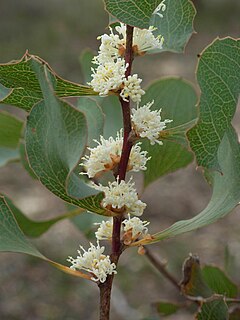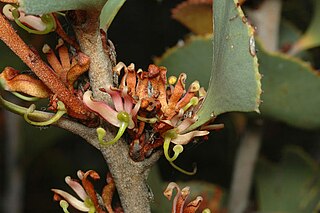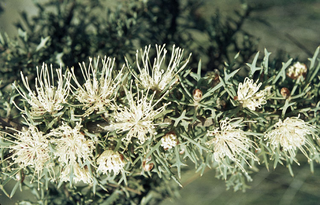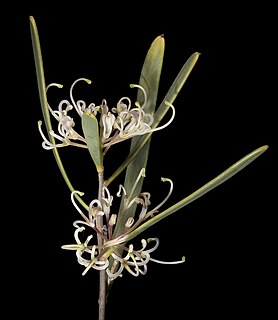
Hakea laurina is shrub or small tree commonly known as kodjet or pin-cushion hakea and is endemic to Western Australia. The Noongar name for the plant is kodjet or kojet. It has red and cream conspicuous globular flowers and lance shaped leaves.

Hakea corymbosa, commonly known as the cauliflower hakea is a plant of the family Proteaceae which is endemic to the south-west of Western Australia. An attractive extremely prickly bush with sweetly scented yellowish flowers. The nectar rich blooms and dense form provides a good habitat for wildlife.

Grevillea crithmifolia is a species of flowering plant in the family Proteaceae and is endemic to the south-west of Western Australia. It is a dense shrub with linear leaves, divided leaves with narrowly oblong lobes, or both, and clusters of pale pink to creamy-white flowers.

Hakea cristata, commonly known as the snail hakea, is a shrub in the family Proteaceae native to Western Australia. An ornamental prickly shrub with attractive foliage and creamy white rounded flowers appearing in profusion in the winter months.

Hakea tephrosperma commonly known as hooked needlewood, is a shrub or small tree species in the family Proteaceae. It has cream flowers, needle-shaped leaves and is one of the taller species adaptable for dry to temperate locations.

Hakea pandanicarpa is a shrub species in the family Proteaceae. It is endemic to south-west Western Australia.

Hakea eriantha, commonly known as tree hakea, is a shrub or small tree endemic to the east coast of Australia. It has white flowers on a woolly stem in leaf axils, long narrow leaves with reddish new growth. Found growing at higher altitudes in moist or sclerophyll Eucalyptus woodland.

Hakea cucullata, commonly known as hood-leaved hakea, cup hakea or scallop hakea, is a species of shrub in the family Proteaceae and is endemic to the south-west of Western Australia. An attractive shrub with unusual distinctive foliage and beautiful large pink, red or deep purple scented flowers.

Grevillea anethifolia, commonly known as spiny cream spider flower, is a species of flowering plant in the family Proteaceae and is endemic to continental Australia. It is an erect shrub with hairy branchlets, lobed leaves, the lobes sharply pointed, and white to pale yellow or cream-coloured flowers.

Grevillea baxteri, commonly known as the Cape Arid grevillea, is a flowering plant of the family Proteaceae and is endemic to the south-west of Western Australia. It is an erect to spreading shrub with pinnatipartite leaves and greenish to fawn or creamy-orange flowers.
Grevillea cunninghamii is a species of flowering plant in the family Proteaceae and is endemic to the north of Western Australia. It is a shrub with egg-shaped leaves with sharply-pointed teeth on the edges, and clusters of red flowers.

Hakea adnata is a shrub in the family Proteaceae native to the south coast of Western Australia. It is multi-stemmed shrub that produces masses of white scented flowers from late winter to spring.

Hakea baxteri, commonly known as fan-leaf hakea , is a shrub in the family Proteaceae native to an area in the Great Southern and Wheatbelt regions of Western Australia. A species noted for its foliage due to its fan-shaped leaves.

Hakea falcata, commonly known as sickle hakea, is a shrub in the family Proteacea and is endemic to southern Western Australia. It has narrow egg-shaped leaves, cream flowers and blooms in spring.

Hakea lasiocarpha, commonly known as long styled hakea, is a shrub in the family Proteacea and is endemic to Western Australia. It has about 30 whitish flowers in clusters in the upper leaf axils, rigid prickly leaves and a limited distribution.
Hakea tuberculata is a flowering plant in the family Proteaceae and is endemic to several isolated areas along the coast in the Peel, South West, Great Southern and Goldfields-Esperance regions of Western Australia. It is an upright shrub with white flowers and rigid, prickly leaves.

Hakea macrocarpa, commonly known as dogwood hakea, is a shrub or tree in the family Proteaceae. It has cream-yellow flowers from May to June. It is native to Western Australia and the Northern Territory.

Hakea stenocarpa is a shrub in the family Proteaceae, commonly known as narrow-fruited hakea. It has scented creamy-white flowers in clusters, often with curling leaves and is endemic to an area in the Mid West, western Wheatbelt, Peel and the South West regions of Western Australia.

Hakea stenophylla is a shrub or tree in the family Proteacea, with sweetly scented creamy-white flowers. It is endemic to Western Australia.

Hakea fraseri, is a species of shrub or small tree commonly known as the corkwood oak, is a shrub in the family Proteaceae and is endemic to northern New South Wales. It has furrowed bark, pendulous foliage and creamy-white flowers in spring.




















